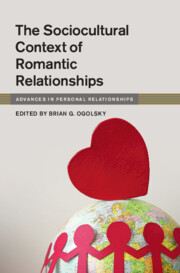Book contents
- The Sociocultural Context of Romantic Relationships
- Advances in Personal Relationships
- The Sociocultural Context of Romantic Relationships
- Copyright page
- Contents
- Contributors
- 1 The Sociocultural Context of Romantic Relationships
- 2 Systemic Racism and Romantic Relationships
- 3 Sociocultural Perspectives on Romantic Relationships
- 4 Gender and Heteronormativity in Romantic Relationships
- 5 Social Class, Neighborhoods, and Romantic Relationships
- 6 Religion and Spirituality in Romantic Relationships
- 7 The Importance of Work in Romantic Relationships
- 8 History and Cohort Effects in Romantic Relationships
- 9 The Legal Meaning of Sex (and Romantic Relationships)
- 10 Romantic Relationships and Traditional Media
- 11 Romantic Relationships and Social Media
- 12 Situating Latinx Immigrant Romantic Relationships in the Context of Illegality
- 13 Romantic Relationships during a Global Pandemic
- Index
- References
10 - Romantic Relationships and Traditional Media
Published online by Cambridge University Press: 19 October 2023
- The Sociocultural Context of Romantic Relationships
- Advances in Personal Relationships
- The Sociocultural Context of Romantic Relationships
- Copyright page
- Contents
- Contributors
- 1 The Sociocultural Context of Romantic Relationships
- 2 Systemic Racism and Romantic Relationships
- 3 Sociocultural Perspectives on Romantic Relationships
- 4 Gender and Heteronormativity in Romantic Relationships
- 5 Social Class, Neighborhoods, and Romantic Relationships
- 6 Religion and Spirituality in Romantic Relationships
- 7 The Importance of Work in Romantic Relationships
- 8 History and Cohort Effects in Romantic Relationships
- 9 The Legal Meaning of Sex (and Romantic Relationships)
- 10 Romantic Relationships and Traditional Media
- 11 Romantic Relationships and Social Media
- 12 Situating Latinx Immigrant Romantic Relationships in the Context of Illegality
- 13 Romantic Relationships during a Global Pandemic
- Index
- References
Summary
The widespread adoption of social media, mobile phones, and online dating apps has drawn more attention toward the importance of media technologies in romantic relationships. However, most observed relational functions and effects of digital media are not novel. Rather, they have been documented previously with traditional media such as books, letters, radio, newspapers, recorded music, television, and the telephone. Romantic relational phenomena manifest across both traditional and digital media due to similar affordances. This chapter provides an overview of research on traditional media across relational processes (mate seeking, relationship initiation, relationship escalation, relationship maintenance, relationship disruption, and relationship dissolution), identifying key social affordances, and introducing relevant theories. We discuss how people use media in relationships, how media consumption affects our relationships, and how people foster relationships with media characters (i.e., parasocial relationships).
- Type
- Chapter
- Information
- The Sociocultural Context of Romantic Relationships , pp. 168 - 200Publisher: Cambridge University PressPrint publication year: 2023



